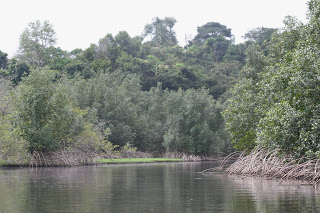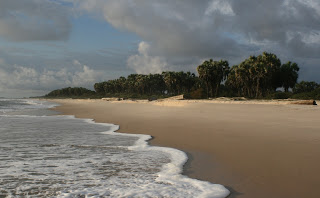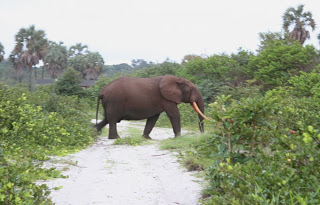Other Highlights from Sette Cama
We also stopped by a house on the lagoon owned by a Dutch man named Herman who often sees manatees feeding in the cove in front of his house. There are large beds of aquatic plants here, primarily Crinum natans. I stopped by here last year but Herman wasn’t home. This year I met him and we sat overlooking the cove while he told me stories about seeing mating herds and adults with calves frolicking in the clear water. Of course they never seem to be there when I am, but DeDe did spot 2 manatees much further out in the lagoon while we were there. Infact, people in the nearby village of Pitonga see manatees year round in this area and it’s one of the places I’m considering as a capture site when I finally get funding to tag manatees.
 Crinum natans with cropped leaves. We often find plants floating on the surface where manatees have recently fed. In this case we were told manatees had been seen at Herman’s cove the previous night.
Crinum natans with cropped leaves. We often find plants floating on the surface where manatees have recently fed. In this case we were told manatees had been seen at Herman’s cove the previous night.
 DeDe keeps watch for manatees from Herman’s lawn.
DeDe keeps watch for manatees from Herman’s lawn. Friday and Saturday we surveyed another small lake, Lac Simba, and a river near the mouth of the lagoon called Moune Mouelle. Both were good habitat but we didn’t see any manatees this time (one sighting at Lac Simba last year).
Friday and Saturday we surveyed another small lake, Lac Simba, and a river near the mouth of the lagoon called Moune Mouelle. Both were good habitat but we didn’t see any manatees this time (one sighting at Lac Simba last year).
Moune Mouelle habitat Forest Buffalo on the river
Forest Buffalo on the river On Sunday I went out with 2 guys from the BBC and Richard (one of the mangabey researchers) to forest on the lagoon where the BBC is planning to build a platform in the tree canopy to film wildlife here. After the documentary is finished, the platform will be donated to the national park for use by ecotourists. The BBC guys selected an enormous sacroglottis tree that overhangs the lagoon. Sacroglottis fruits are a favorite of elephants and red-capped mangabeys, so at certain times of the year the wildlife will come right to the platform. It might be possible to even see manatees from this site, since they have been recorded feeding along the banks here.
On Sunday I went out with 2 guys from the BBC and Richard (one of the mangabey researchers) to forest on the lagoon where the BBC is planning to build a platform in the tree canopy to film wildlife here. After the documentary is finished, the platform will be donated to the national park for use by ecotourists. The BBC guys selected an enormous sacroglottis tree that overhangs the lagoon. Sacroglottis fruits are a favorite of elephants and red-capped mangabeys, so at certain times of the year the wildlife will come right to the platform. It might be possible to even see manatees from this site, since they have been recorded feeding along the banks here.
 Cool lizard in the forest
Cool lizard in the forest In the afternoons I spent time entering data and writing on my computer, and then going for walks on the beautiful beach near the house.
In the afternoons I spent time entering data and writing on my computer, and then going for walks on the beautiful beach near the house. One day I noticed fresh elephant tracks as I walked out to the beach. The next thing I knew, I heard a big “crunch” sound on my right, and I looked over to see a big bull standing in the bushes eating fruit right next to the trail. After taking a quick photo I moved away. Later, as I came back from my walk, 3 elephants crossed the path right in front of me.
One day I noticed fresh elephant tracks as I walked out to the beach. The next thing I knew, I heard a big “crunch” sound on my right, and I looked over to see a big bull standing in the bushes eating fruit right next to the trail. After taking a quick photo I moved away. Later, as I came back from my walk, 3 elephants crossed the path right in front of me. 




Anonymous
November 23, 2008 at 1:43 pmHey girl! I love reading your blog and hearing your stories!!! Congrats on the awesome adventure… Miss ya
Anonymous
January 26, 2009 at 2:55 pmThree hef-a-lumps! Sooo cool. Love the blue toe nail polish in the foot print & the cuuute lizard. This is as far as I've gotten but it's all excellent. Great job. Looking forward to the rest… xoxo, me